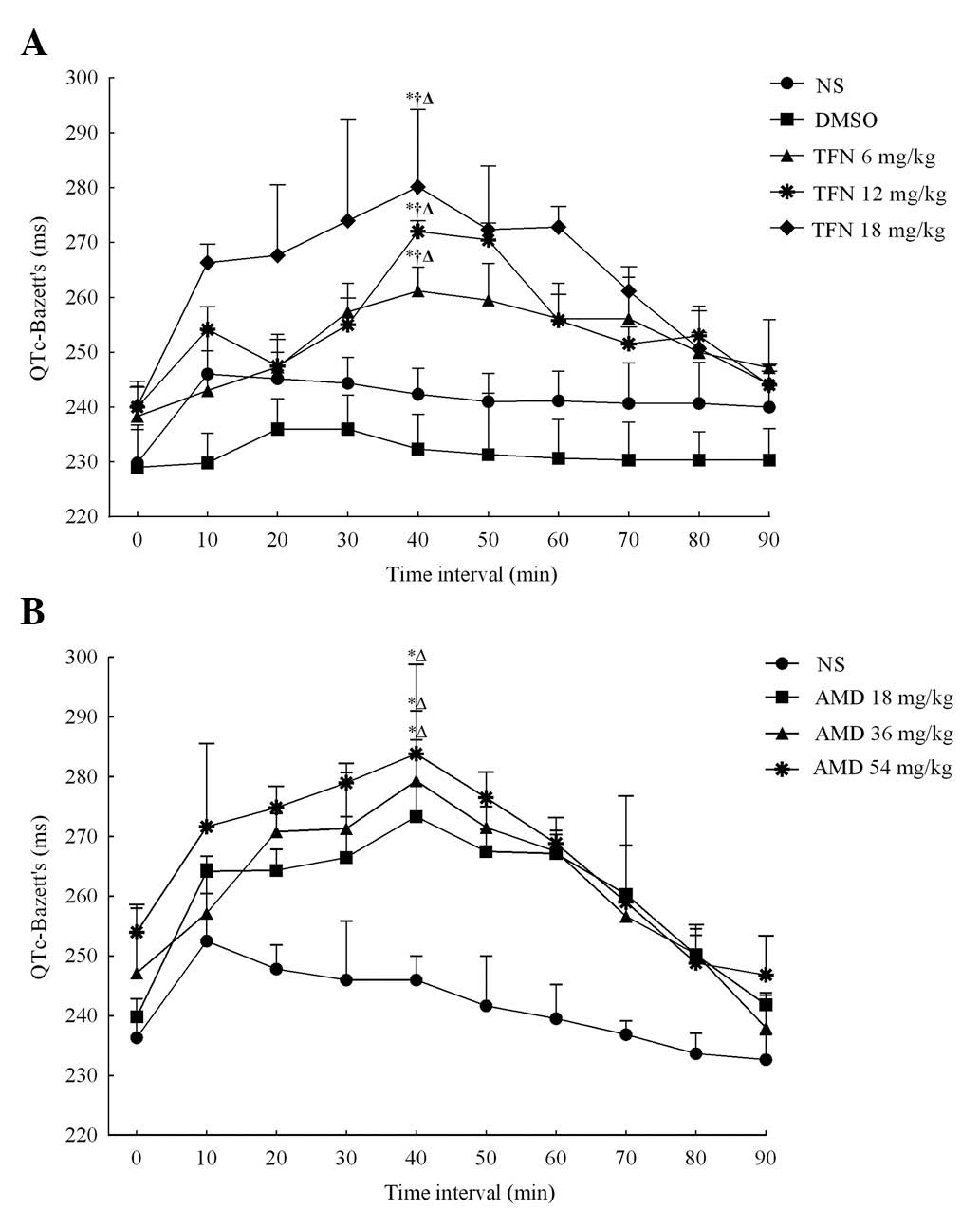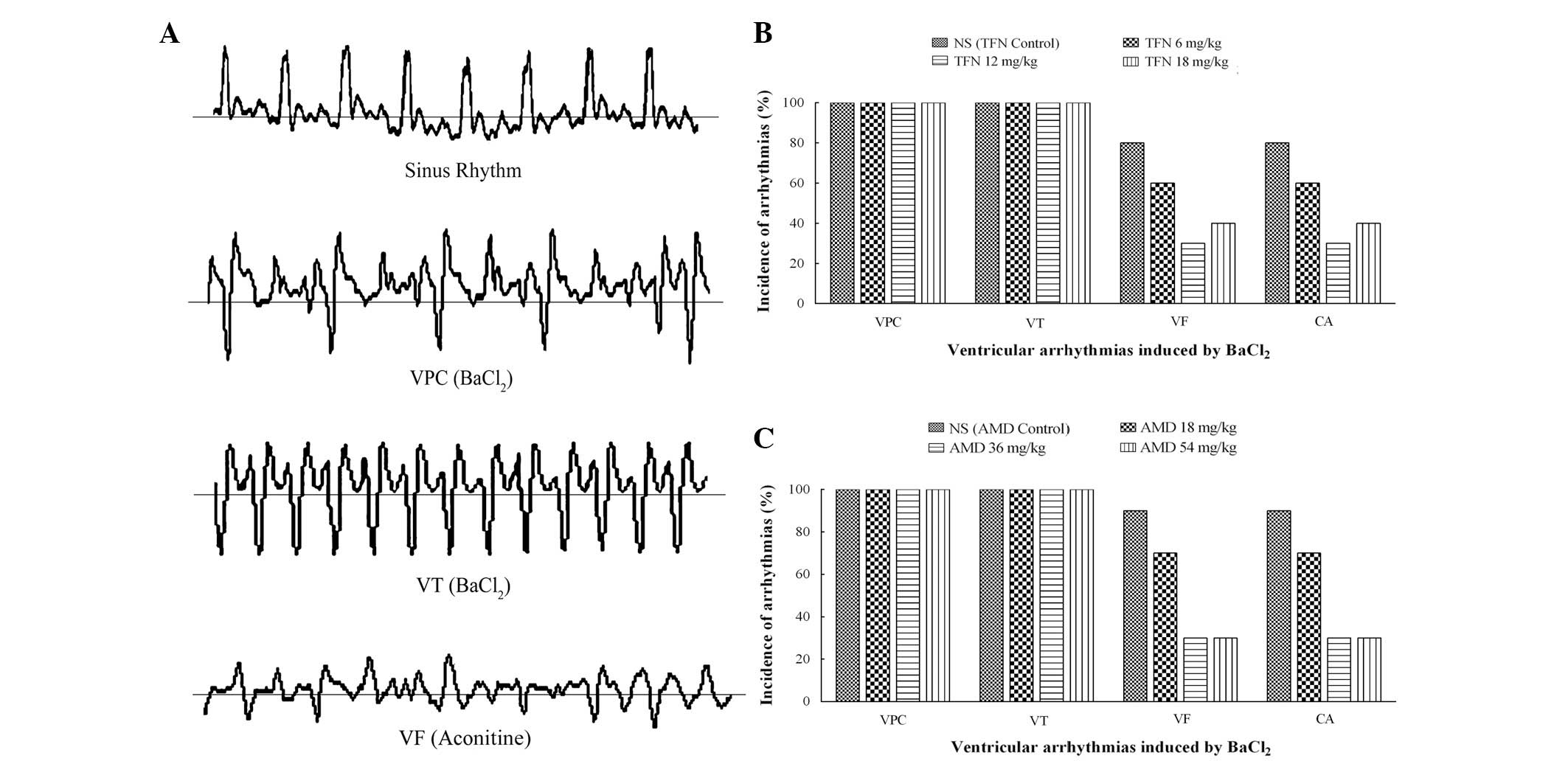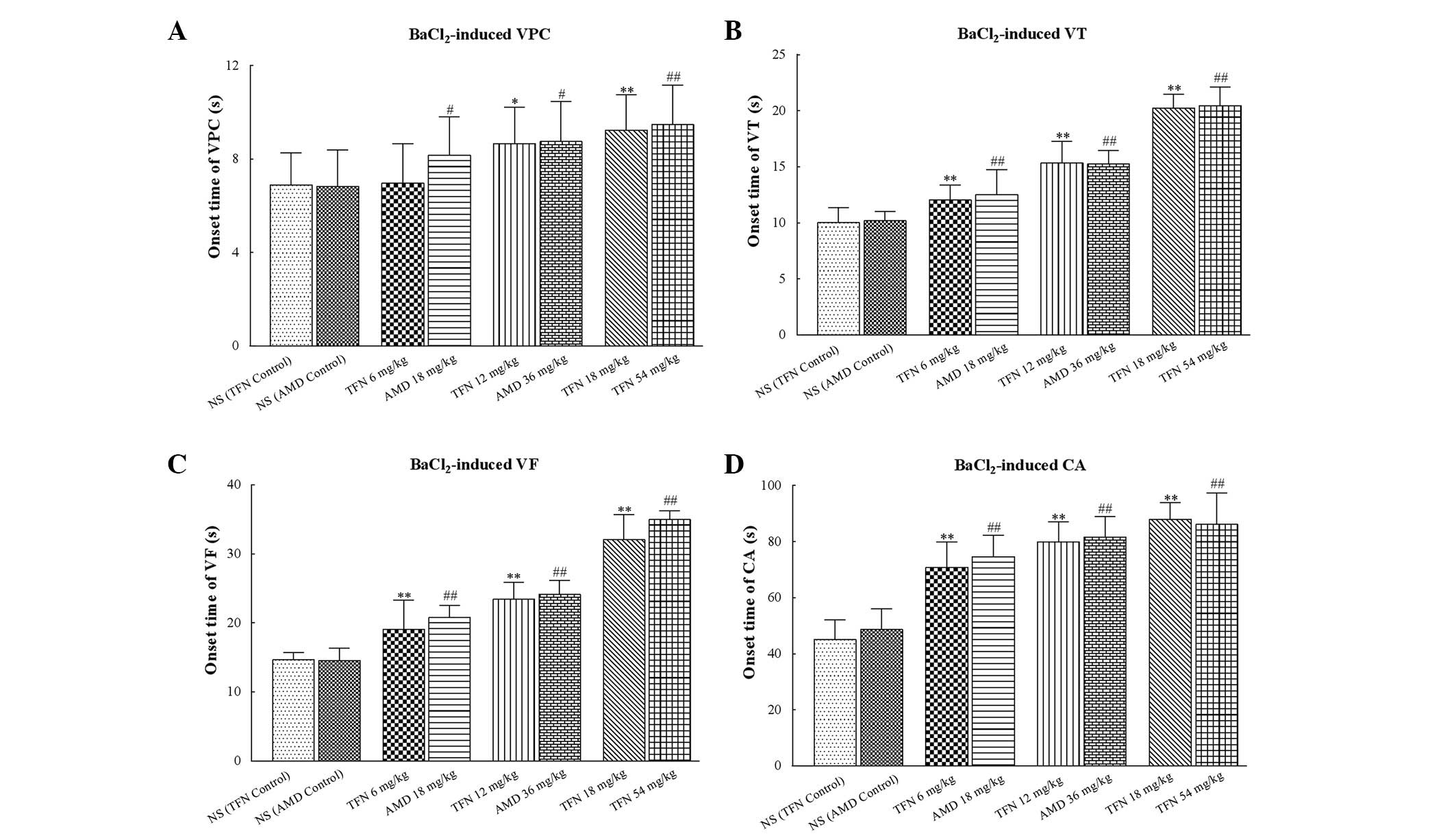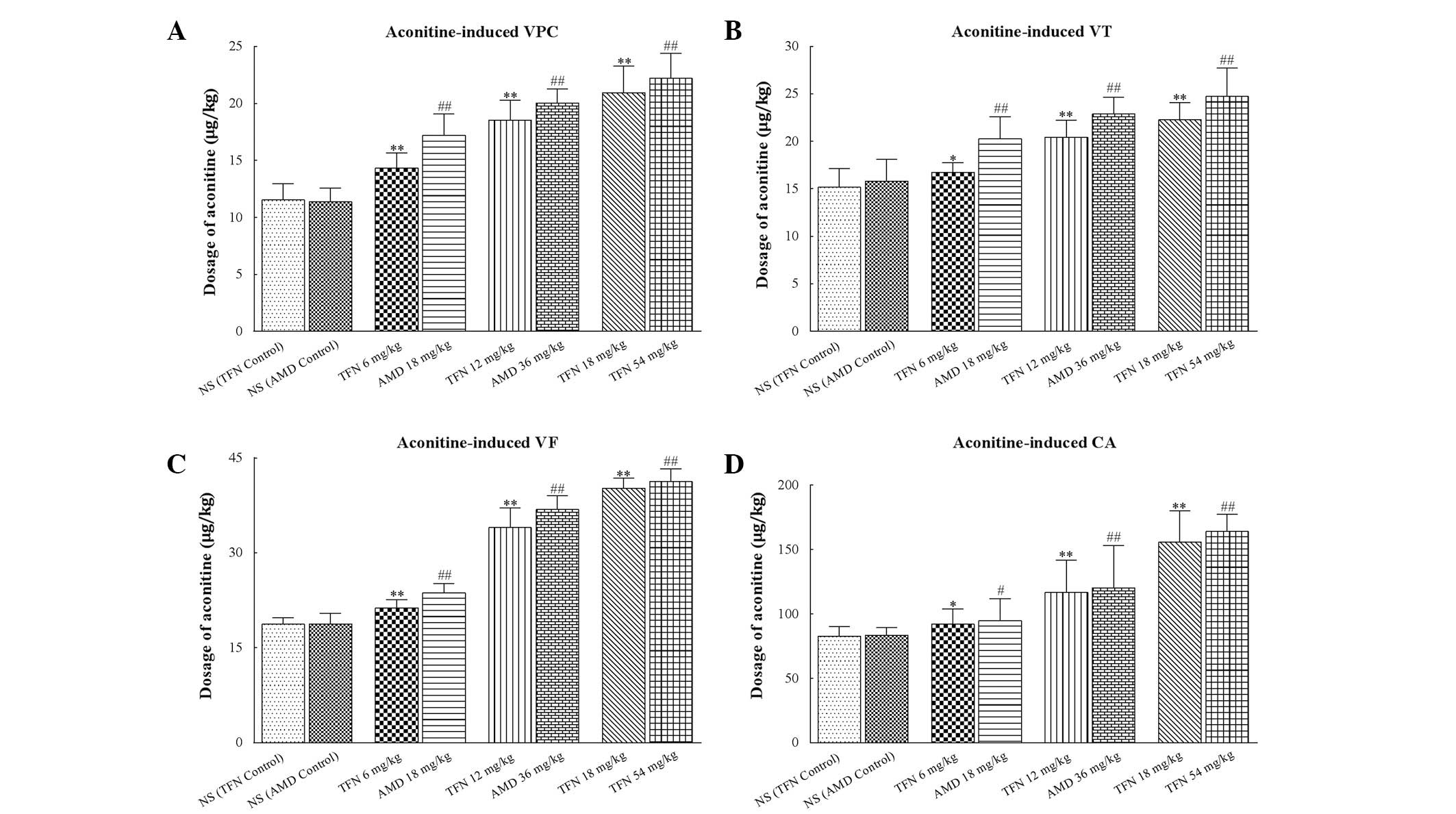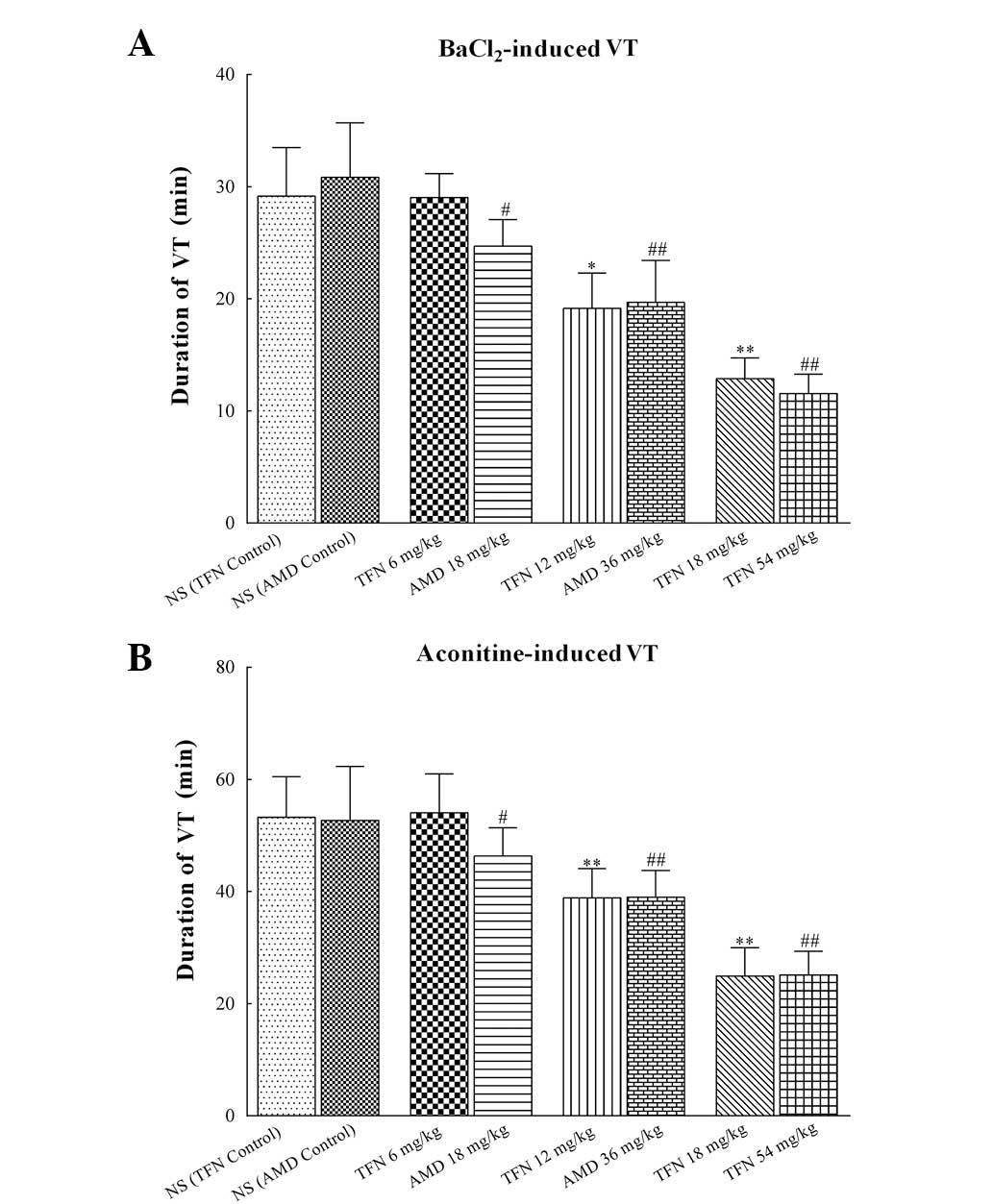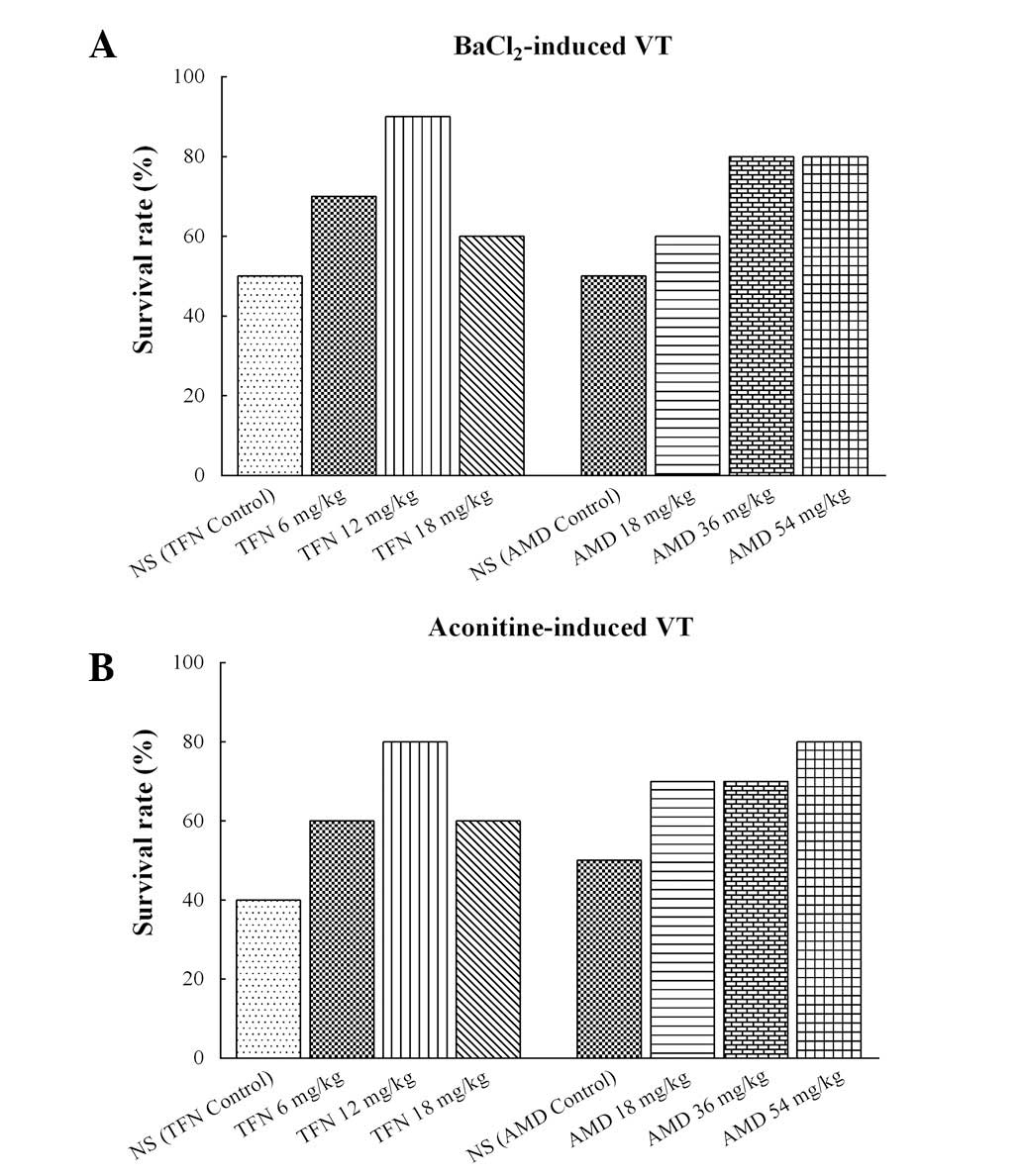|
1
|
Ghoneim M, Issa R and Tawfik A: Assay of
terfenadine in pharmaceutical formulation and human plasma by
adsorptive stripping voltammetry. J Pharm Biomed Anal. 26:593–598.
2001. View Article : Google Scholar : PubMed/NCBI
|
|
2
|
Monahan BP, Ferguson CL, Killeavy ES, et
al: Torsades de pointes occurring in association with terfenadine
use. JAMA. 264:2788–2790. 1990. View Article : Google Scholar : PubMed/NCBI
|
|
3
|
Smith SJ: Cardiovascular toxicity of
antihistamines. Otolaryngol Head Neck Surg. 111:348–354.
1994.PubMed/NCBI
|
|
4
|
Lu HR, Hermans AN and Gallacher DJ: Does
terfenadine-induced ventricular tachycardia/fibrillation directly
relate to its QT prolongation and Torsades de Pointes? Br J
Pharmacol. 166:1490–1502. 2012. View Article : Google Scholar
|
|
5
|
Kamiya K, Niwa R, Morishima M, Honjo H and
Sanguinetti MC: Molecular determinants of hERG channel block by
terfenadine and cisapride. J Pharmacol Sci. 108:301–307. 2008.
View Article : Google Scholar : PubMed/NCBI
|
|
6
|
Testai L, Breschi MC, Martinotti E and
Calderone V: QT prolongation in guinea pigs for preliminary
screening of torsadogenicity of drugs and drug-candidates. II. J
Appl Toxicol. 27:270–275. 2007. View
Article : Google Scholar : PubMed/NCBI
|
|
7
|
Iribarren C, Round AD, Peng JA, et al:
Validation of a population-based method to assess drug-induced
alterations in the QT interval: a self-controlled crossover study.
Pharmacoepidemiol Drug Saf. 22:1222–1232. 2013. View Article : Google Scholar : PubMed/NCBI
|
|
8
|
Li XW, Niu SC, Zhang XP, et al:
Differences of promethazine and terfenadine on ion channels in
guinea pig ventricular myocytes. Chin Med J (Engl). 119:944–947.
2006.PubMed/NCBI
|
|
9
|
Woosley RL, Chen Y, Freiman JP and Gillis
RA: Mechanism of the cardiotoxic actions of terfenadine. JAMA.
269:1532–1536. 1993. View Article : Google Scholar : PubMed/NCBI
|
|
10
|
Rajput SK, Singh JN and Sharma SS:
Evaluation of terfenadine and ketoconazole-induced QT prolongation
in conscious telemetered guinea pigs. Pharmacol Rep. 62:683–688.
2010. View Article : Google Scholar
|
|
11
|
Aslanian R, Piwinski JJ, Zhu X, et al:
Structural determinants for histamine H(1) affinity, hERG affinity
and QTc prolongation in a series of terfenadine analogs. Bioorg Med
Chem Lett. 19:5043–5047. 2009. View Article : Google Scholar : PubMed/NCBI
|
|
12
|
Mehta A, Chung Y, Sequiera GL, et al:
Pharmacoelectrophysiology of viral-free induced pluripotent stem
cell-derived human cardiomyocytes. Toxicol Sci. 131:458–69. 2013.
View Article : Google Scholar : PubMed/NCBI
|
|
13
|
Stork D, Timin EN, Berjukow S, et al:
State dependent dissociation of HERG channel inhibitors. Br J
Pharmacol. 151:1368–76. 2007. View Article : Google Scholar : PubMed/NCBI
|
|
14
|
Davies AJ, Harindra V, McEwan A and Ghose
RR: Cardiotoxic effect with convulsions in terfenadine overdose.
BMJ. 298:3251989. View Article : Google Scholar : PubMed/NCBI
|
|
15
|
Hess P, Rey M, Wanner D, Steiner B and
Clozel M: Measurements of blood pressure and electrocardiogram in
conscious freely moving guineapigs: a model for screening QT
interval prolongation effects. Lab Anim. 41:470–80. 2007.
View Article : Google Scholar : PubMed/NCBI
|
|
16
|
Huang W, Wang Y, Cao YG, et al:
Antiarrhythmic effects and ionic mechanisms of allicin on
myocardial injury of diabetic rats induced by streptozotocin.
Naunyn Schmiedebergs Arch Pharmacol. 386:697–704. 2013. View Article : Google Scholar : PubMed/NCBI
|
|
17
|
Wilhelms M, Rombach C, Scholz EP, Dössel O
and Seemann G: Impact of amiodarone and cisapride on simulated
human ventricular electrophysiology and electrocardiograms.
Europace. 14:v90–v96. 2012. View Article : Google Scholar : PubMed/NCBI
|
|
18
|
Taniguchi T, Uesugi M, Arai T, et al:
Chronic probucol treatment decreases the slow component of the
delayed-rectifier potassium current in CHO cells transfected with
KCNQ1 and KCNE1: a novel mechanism of QT prolongation. J Cardiovasc
Pharmacol. 59:377–386. 2012. View Article : Google Scholar
|
|
19
|
Khisatmutdinova RIu, Baschenko NZh,
Zarudii FS, et al: Some aspects of the antiarrhythmic effect of
glialin. Eksp Klin Farmakol. 69:26–28. 2006.PubMed/NCBI
|
|
20
|
Huang W, Wang Y, Cao YG, et al:
Antiarrhythmic effects and ionic mechanisms of allicin on
myocardial injury of diabetic rats induced by streptozotocin.
Naunyn Schmiedebergs Arch Pharmacol. 386:697–704. 2013. View Article : Google Scholar : PubMed/NCBI
|
|
21
|
Wada K, Nihira M, Hayakawa H, et al:
Effects of long-term administrations of aconitine on
electrocardiogram and tissue concentrations of aconitine and its
metabolites in mice. Forensic Sci Int. 148:21–29. 2005. View Article : Google Scholar : PubMed/NCBI
|
|
22
|
Gao Y, Li P, Ma LX, et al: Effects of
acute administration of ethanol on experimental arrhythmia. Chin J
Physiol. 55:307–313. 2012.PubMed/NCBI
|
|
23
|
Testai L, Cecchetti V, Sabatini S, et al:
Effects of K openers on the QT prolongation induced by
HERG-blocking drugs in guinea-pigs. J Pharm Pharmacol. 62:924–930.
2010.PubMed/NCBI
|
|
24
|
Zhang YH, Cheng H, Alexeenko VA, Dempsey
CE and Hancox JC: Characterization of recombinant hERG K(+) channel
inhibition by the active metabolite of amiodarone
desethyl-amiodarone. J Electrocardiol. Sep–Oct;43(5): 440–8. 2010.
View Article : Google Scholar
|
|
25
|
Coast GM: Intracellular Na+,
K+ and Cl− activities in Acheta domesticus Malpighian
tubules and the response to a diuretic kinin neuropeptide. J Exp
Biol. 215:2774–2785. 2012.PubMed/NCBI
|
|
26
|
Discala F, Belachgar F, Planelles G, Hulin
P and Anagnostopoulos T: Barium- or quinine-induced depolarization
activates K+, Na+ and cationic conductances
in frog proximal tubular cells. J Physiol. 448:525–537. 1992.
View Article : Google Scholar : PubMed/NCBI
|
|
27
|
Kehl SJ, Fedida D and Wang Z: External
Ba(2+) block of Kv4.2 channels is enhanced in the
closed-inactivated state. Am J Physiol Cell Physiol. 304:C370–C381.
2013. View Article : Google Scholar : PubMed/NCBI
|
|
28
|
Rowley CN and Roux B: A computational
study of barium blockades in the KcsA potassium channel based on
multi-ion potential of mean force calculations and free energy
perturbation. J Gen Physiol. 142(4): 451–463. 2013. View Article : Google Scholar
|
|
29
|
Kubo Y, Baldwin TJ, Jan YN and Jan LY:
Primary structure and functional expression of a mouse inward
rectifier potassium channel. Nature. 362:127–33. 1993. View Article : Google Scholar : PubMed/NCBI
|
|
30
|
Ming Z and Nordin C: Terfenadine blocks
time-dependent Ca2+, Na+, and K+
channels in guinea pig ventricular myocytes. J Cardiovasc
Pharmacol. 26:761–769. 1995. View Article : Google Scholar : PubMed/NCBI
|
|
31
|
Lalevée N, Nargeot J, Barrére-Lemaire S,
Gautier P and Richard S: Effects of amiodarone and dronedarone on
voltage-dependent sodium current in human cardiomyocytes. J
Cardiovasc Electrophysiol. 14:885–90. 2003.PubMed/NCBI
|
|
32
|
Zhou SS, Yang J, Li YQ, et al: Effect of
Cl− channel blockers on aconitine-induced arrhythmias in rat heart.
Exp Physiol. 90:865–872. 2005.
|
|
33
|
Moreno JD and Clancy CE: Pathophysiology
of the cardiac late Na current and its potential as a drug target.
J Mol Cell Cardiol. 52:608–19. 2012. View Article : Google Scholar : PubMed/NCBI
|
|
34
|
Goegelein H, Gautier P, Roccon A, O’Connor
S and Ruetten H: Effects of the novel amiodarone-like compound
SAR114646A on cardiac ion channels and ventricular arrhythmias in
rats. Naunyn Schmiedebergs Arch Pharmacol. 384:231–244. 2011.
View Article : Google Scholar : PubMed/NCBI
|
|
35
|
Garteiz DA, Hook RH, Walker BJ and
Okerholm RA: Pharmacokinetics and biotransformation studies of
terfenadine in man. Arzneimittelforschung. 32:1185–1190.
1982.PubMed/NCBI
|
|
36
|
Jones BC, Hyland R, Ackland M, Tyman CA
and Smith DA: Interaction of terfenadine and its primary
metabolites with cytochrome P450 2D6. Drug Metab Dispos. 26:875–82.
1998.PubMed/NCBI
|
|
37
|
Eckardt L and Breithardt G: Is there a
role for amiodarone in the era of the implantable
cardioverter-defibrillator? Heart Rhythm. 3:484–487. 2006.
View Article : Google Scholar : PubMed/NCBI
|
|
38
|
Echt DS, Liebson PR, Mitchell LB, et al:
Mortality and morbidity in patients receiving encainide,
flecainide, or placebo. The Cardiac Arrhythmia Suppression Trial N
Engl J Med. 324:781–788. 1991.PubMed/NCBI
|
|
39
|
Naccarelli GV, Wolbrette DL, Samii S, et
al: A review of the appropriate and inappropriate use of
dronedarone: lessons learned from controlled studies and regulatory
submission. J Cardiovasc Pharmacol Ther. 15:24S–30S.
2010.PubMed/NCBI
|
|
40
|
Maseeh-uz-Zaman, Fatima N and Sajjad Z:
Amiodarone therapy: don’t forget thyroid. J Pak Med Assoc.
62:268–272. 2012.PubMed/NCBI
|
|
41
|
Garg J, Agrawal N, Marballi A, et al:
Amiodarone induced pulmonary toxicity: An unusual response to
steroids. Am J Case Rep. 13:62–65. 2012. View Article : Google Scholar : PubMed/NCBI
|



